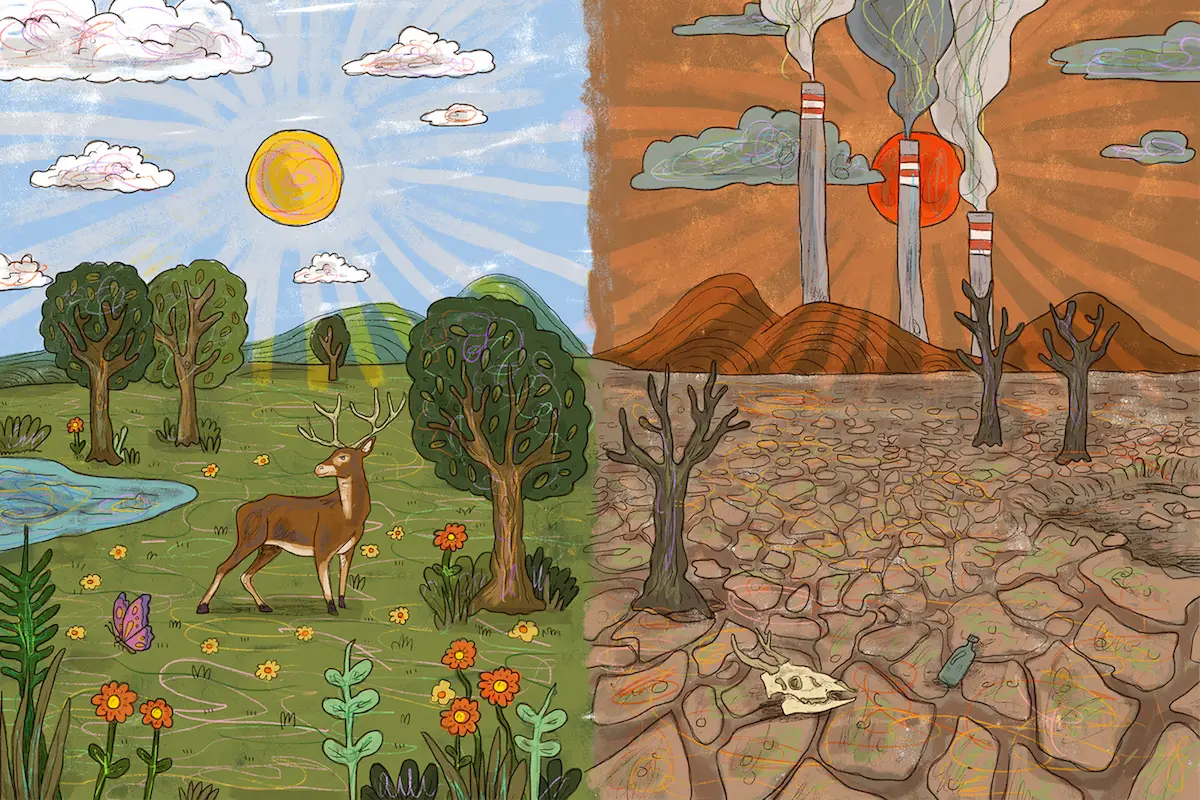Most people know that the ice caps are melting, species are dying out and the ozone layer is rapidly degrading. At the same time, most people also push that information into the recesses of their minds because they think that they alone cannot make a change. A recent social media trend, the #10YearChallenge, has forced millions of people to, once again, acknowledge the disturbing nature of climate change.
The trend started as people began posting side-by-side pictures of themselves 10 years apart, but it quickly took a turn for the serious when people started comparing pictures of the environment over 10 years. Most of these comparisons are captioned with “The only #10YearChallenge we should care about.”
The images illustrate what we already know about climate change. One of the most popular images shows a polar bear in 2009 that looks healthy, while the image to the right shows a sick, underweight polar bear who has been a victim of global warming. The question is, is a social media trend impactful enough to start the fight against climate change?
While the #10YearChallenge starts a long-needed conversation about the environment, it does not give viewers the data behind climate change, which are much more startling than the photographs. To start off, most of the climate change up to this point has all happened in just the last 35 years, with the five warmest years ever recorded all happening since 2010. It’s also still getting worse. In the last decade, ice loss in Antarctica has tripled, which means about 119 billion tons lost every year.
Even more unsettling, it is 95 percent certain that global warming is entirely caused by humans. Even though most people turn a blind eye to the environmental changes happening around them, as the planet’s conditions steadily deteriorate, they will be forced to acknowledge what humans have done, and by then, it might be too late.
https://www.instagram.com/p/Bsu87fFBYUO/?utm_source=ig_embed
The #10YearChallenge photos also fail to portray how human life will be affected by climate change. This could be a huge motivating factor for viewers, as most people do not feel personally affected by melting ice caps and glaciers. According to the Intergovernmental Panel on Climate Change (IPCC), the Earth has about a decade before the global temperature will start causing major damage.
A raised global temperature would expose new regions to harmful weather events that they’ve never experienced before, such as droughts, hurricanes, flooding, wildfires and extreme precipitation. In areas where these weather events already exist, they will become much worse.
The frequency of heat waves and life-threatening temperatures will also increase, even in urban areas. High temperatures will also expose humans to an unhealthy amount of ground-level ozone, an air pollutant that causes respiratory issues and lowers life expectancy.
Climate warming heats the ocean as well. A warmer ocean means a breeding ground for bacteria that is harmful to humans and will result in many more water-borne illnesses. When someone sees the side by side of the polar bear, they do not realize that climate change could cause a similar degradation in the health of the human race.
To truly motivate individuals to push against climate change, they need to know that the government is aware of the severity of climate change and has simply not done enough — or anything — to save the planet. The #10YearChallenge does not spread this information.
In 2015, the IPCC released a study for the Paris agreement, a contract signed by 195 countries promising to work toward lower emission levels. The results warned that in order to avoid dangerous climate temperatures, emissions would have to be reduced by at least 1 billion tons annually. They also wrote that this initiative would have to begin immediately; that was three years ago, and emission levels have still been increasing since then.
Trump withdrew from the Paris agreement in 2017 because he saw the contract as economically harmful to the American businesses that create a large portion of the carbon emissions. So many governments, including the U.S. government, are aware of the dangerous rate and consequences of climate change, but are unwilling to implement the radical policies required to begin saving the planet.
https://www.instagram.com/p/BstPq2Lly4M/?utm_source=ig_embed
To lower emissions, many factories would have to implement a new technology called carbon capture and storage (CCS). Currently, factory carbon emissions are sent directly into the air, but carbon capture and storage systems funnel the carbon dioxide underground instead. Governments across the globe would also have to start closing coal plants, as they are the most harmful factories to the environment.
One of the easier policy changes that countries can make to lower carbon-dioxide emissions regards transportation. Transportation is the largest contributor to the world’s greenhouse gas emissions at 28 percent. To reduce transportation emissions, the government would have to push for transportation that uses renewable energy. Currently, only 4 percent of transportation uses renewable energy.
Another way that the IPCC suggests countries can fight against global warming is to launch negative emission measures that take existing carbon dioxide out of the atmosphere, and this can be as easy as planting more trees. The most significant things you can do to fight against climate change include switching your home to a renewable energy source, like solar power, as well as switching to an electric car. But, many individuals are not willing to invest the time and money required to lower their carbon footprint. So ultimately, policy changes will be the only way to make a significant impact on climate change.
The #10YearChallenge has opened many eyes to the reality of global warming. That polar bear might tug at your heart strings, but to truly motivate individuals to work against climate change, we have to acknowledge its gross truth.
The challenge does not tell you that in another 10 years, the human race will be the ones suffering from climate change. It does not let you know who and what is causing the global temperature to rise. Maybe most importantly, the #10YearChallenge doesn’t tell us what our governments know but aren’t doing.
This trend very well may be what it takes for citizens to finally start pushing for policy changes that could save the Earth; however, it is going to take more than a retweet to educate people about the state of the planet.
















